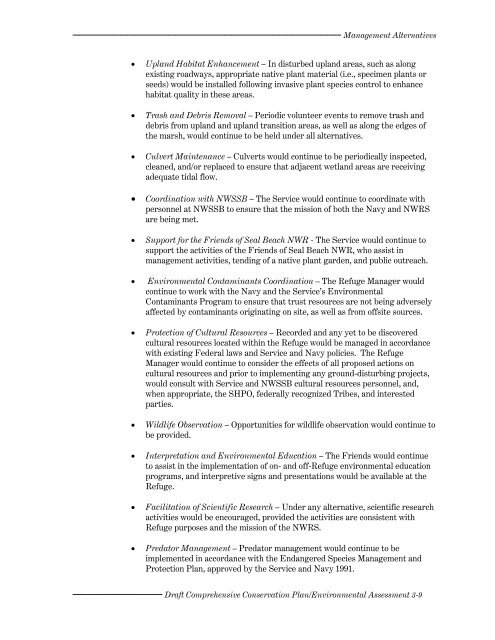Chapters 1 - U.S. Fish and Wildlife Service
Chapters 1 - U.S. Fish and Wildlife Service
Chapters 1 - U.S. Fish and Wildlife Service
You also want an ePaper? Increase the reach of your titles
YUMPU automatically turns print PDFs into web optimized ePapers that Google loves.
Management Alternatives<br />
Upl<strong>and</strong> Habitat Enhancement – In disturbed upl<strong>and</strong> areas, such as along<br />
existing roadways, appropriate native plant material (i.e., specimen plants or<br />
seeds) would be installed following invasive plant species control to enhance<br />
habitat quality in these areas.<br />
Trash <strong>and</strong> Debris Removal – Periodic volunteer events to remove trash <strong>and</strong><br />
debris from upl<strong>and</strong> <strong>and</strong> upl<strong>and</strong> transition areas, as well as along the edges of<br />
the marsh, would continue to be held under all alternatives.<br />
Culvert Maintenance – Culverts would continue to be periodically inspected,<br />
cleaned, <strong>and</strong>/or replaced to ensure that adjacent wetl<strong>and</strong> areas are receiving<br />
adequate tidal flow.<br />
Coordination with NWSSB – The <strong>Service</strong> would continue to coordinate with<br />
personnel at NWSSB to ensure that the mission of both the Navy <strong>and</strong> NWRS<br />
are being met.<br />
Support for the Friends of Seal Beach NWR - The <strong>Service</strong> would continue to<br />
support the activities of the Friends of Seal Beach NWR, who assist in<br />
management activities, tending of a native plant garden, <strong>and</strong> public outreach.<br />
Environmental Contaminants Coordination – The Refuge Manager would<br />
continue to work with the Navy <strong>and</strong> the <strong>Service</strong>’s Environmental<br />
Contaminants Program to ensure that trust resources are not being adversely<br />
affected by contaminants originating on site, as well as from offsite sources.<br />
Protection of Cultural Resources – Recorded <strong>and</strong> any yet to be discovered<br />
cultural resources located within the Refuge would be managed in accordance<br />
with existing Federal laws <strong>and</strong> <strong>Service</strong> <strong>and</strong> Navy policies. The Refuge<br />
Manager would continue to consider the effects of all proposed actions on<br />
cultural resources <strong>and</strong> prior to implementing any ground-disturbing projects,<br />
would consult with <strong>Service</strong> <strong>and</strong> NWSSB cultural resources personnel, <strong>and</strong>,<br />
when appropriate, the SHPO, federally recognized Tribes, <strong>and</strong> interested<br />
parties.<br />
<strong>Wildlife</strong> Observation – Opportunities for wildlife observation would continue to<br />
be provided.<br />
Interpretation <strong>and</strong> Environmental Education – The Friends would continue<br />
to assist in the implementation of on- <strong>and</strong> off-Refuge environmental education<br />
programs, <strong>and</strong> interpretive signs <strong>and</strong> presentations would be available at the<br />
Refuge.<br />
Facilitation of Scientific Research – Under any alternative, scientific research<br />
activities would be encouraged, provided the activities are consistent with<br />
Refuge purposes <strong>and</strong> the mission of the NWRS.<br />
Predator Management – Predator management would continue to be<br />
implemented in accordance with the Endangered Species Management <strong>and</strong><br />
Protection Plan, approved by the <strong>Service</strong> <strong>and</strong> Navy 1991.<br />
Draft Comprehensive Conservation Plan/Environmental Assessment 3-9

















